‘We have now on our planet the largest generation of children Earth has ever seen. Through Earth Speakr, they showed us that they know what is happening and they know what needs to be done. And they know what kind of world they dream of. It is up to us to listen and take action.’ – Olafur Eliasson in ‘Talking to You’, 2022

Starting 22 September 2022, the Fondazione Palazzo Strozzi will be hosting a major exhibition 'Nel tuo tempo', exploring the art of Olafur Eliasson, whose multifaceted output invariably places the visitor at the heart of his reflection on the notion of shared experience and interaction with reality. Image: 'Firefly double-polyhedron sphere experiment', 2020 (photo: Jens Ziehe).
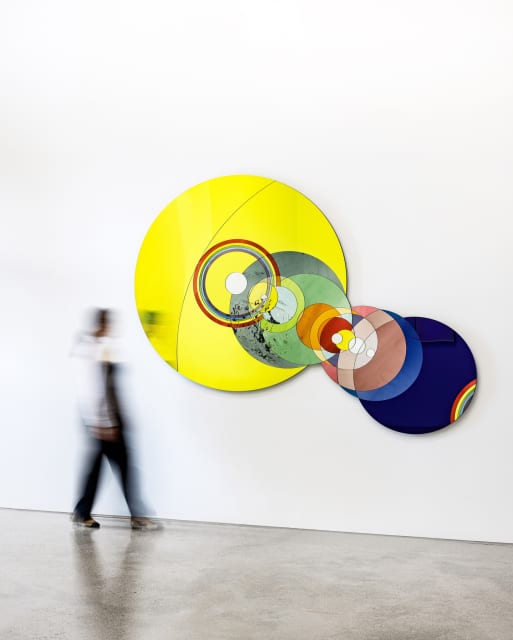
Installation view of ‘Seeing sensitivity flare’, 2022 in Olafur Eliasson’s ‘Inside the new blind spots’ solo exhibition at PKM Gallery, Seoul. Photo: Yongjoon Choi / PKM Gallery

Installation view of Olafur Eliasson’s current solo exhibition ‘Inside the new blind spots’ at PKM Gallery, Seoul. Photo: Yongjoon Choi / PKM Gallery
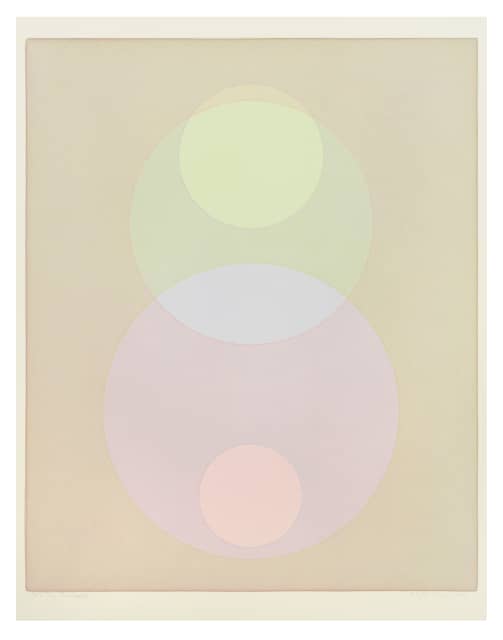
‘Feeling backward’, watercolour and pencil on paper, 2022. Photo credit: Jens Ziehe
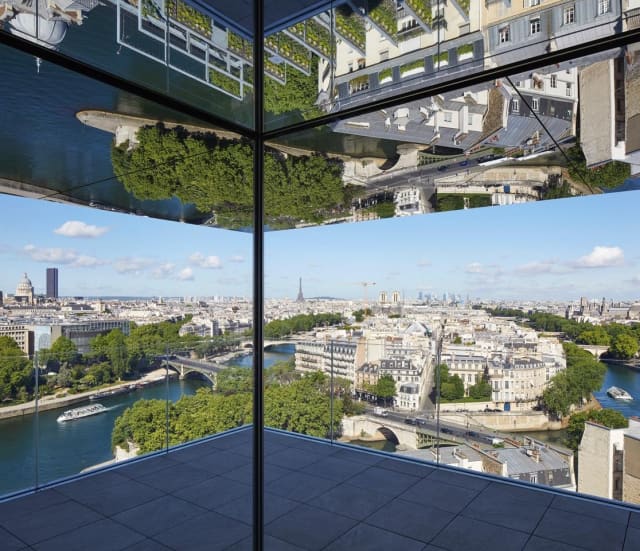
‘The Seeing City’ is a new site-specific, permanent artistic installation designed by Studio Other Spaces (a studio for spatial experimentation co-founded by Olafur Eliasson and Sebastian Behmann) for the top two floors of the former Préfecture de Paris on Boulevard Morland.

‘Sun window’, installed Kunsthalle Wien, 1997. Some of the glass panes in a pre-existing window frame are covered with colour filters so that when the sun shines, the coloured glass creates a colourful pattern in the room inside.
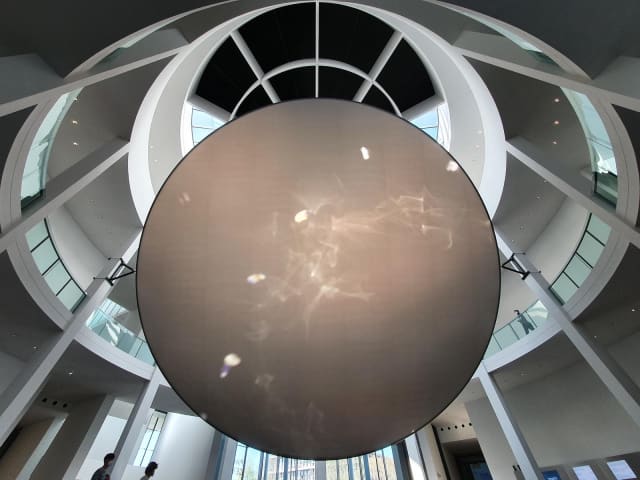
‘Sonnenenergie 22’ (Solar energy 22), 2022. Currently on view at the Pinakothek der Moderne in Munich. Photo: Gunnar Gustafsson

https://www.youtube.com/watch?v=A8MP_nyqNJk
In celebration of Earth Day, you can watch the short film ‘Talking to You’ from Earth Speakr. Directed by Anni Ólafsdóttir. Narrated by Olafur Eliasson. Story and script by Eva Lind Höskulddsdóttir, Anni Ólafsdóttir, and Andri Snær Magnason. Based on messages from more than 10,000 children in more than 70 languages, all made with Earth Speakr.

‘Sonnenenergie 22’, 2022. On view at Pinakothek der Moderne in Munich from the spring equinox to the fall equinox of 2022.
‘We humans are very familiar with the extraordinary importance of sunlight for all life on earth – after all, the path of the sun shapes the very rhythm of life and provides orientation in our world. The earth’s daily rotation and annual orbit make the sun the natural clock for all living creatures on our planet.’ – Olafur Eliasson
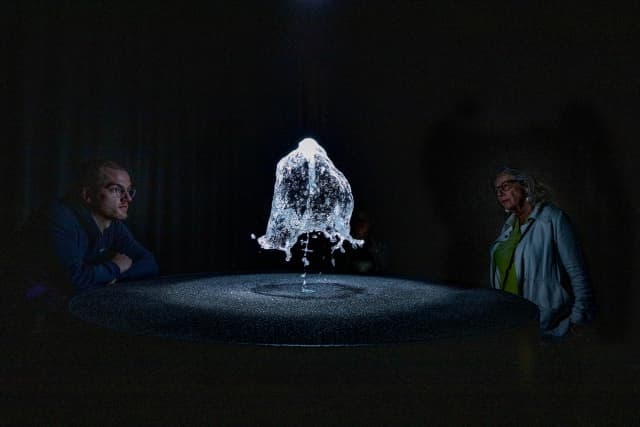
‘Big Bang Fountain’, 2014. Installed at Tate Modern in London, 2019. Photo: Anders Sune Berg
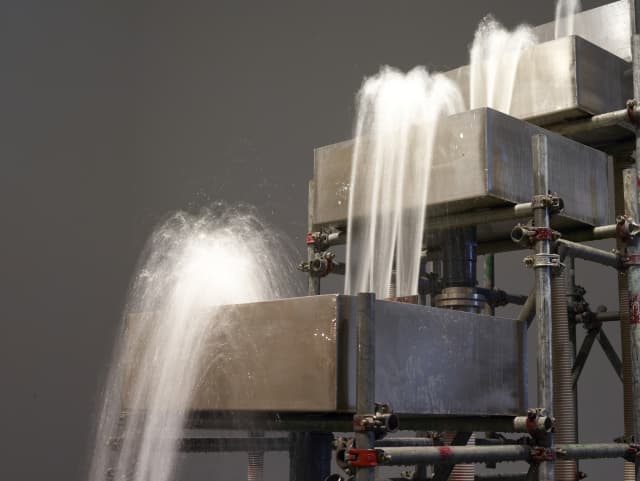
‘Reversed waterfall’, 1998. TBA21 Thyssen-Bornemisza Art Contemporary collection. Now on view as part of the group exhibition ‘Abundant Futures’, curated by Daniela Zyman at Centro de Creación Contemporánea de Andalucía in Córdoba. Photo: Hyunsoo Kim
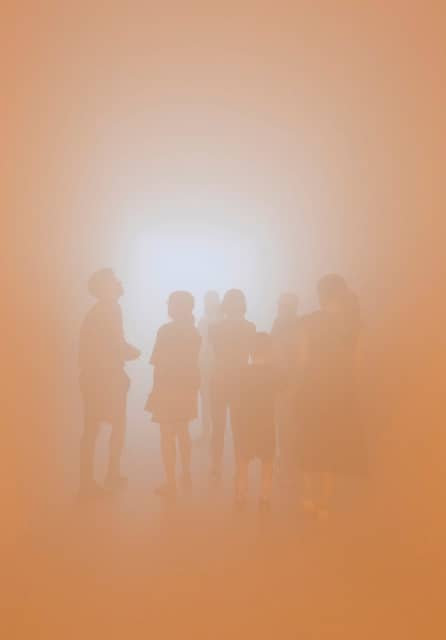
‘Din blinde passager’ (Your blind passenger), 2010. Photo: Anders Sune Berg
Olafur Eliasson explores where we are now and how we navigate – in our everyday lives and in the highly complex world of today. One thing is to inquire into our sense of presence; another is to consider where we are going and what the future will look like… There’s only a slight risk of getting lost. Self-reflection and partial knowledge may accompany you.

Detail of ‘Unforgetting solar exposure’, watercolour, 2020
In this moment, we are reminded of how crises of war, authoritarianism, neoliberalism, and climate are highly intersectional. Each crisis cannot be tackled as a distinct challenge, they are all part of one picture.
In an article written in the first days of the war on Ukraine, Bill McKibben put forward an idea: ‘One way to dramatically reduce Putin’s power is to get off oil and gas … So now is the moment to remind ourselves that, in the last decade, scientists and engineers have dropped the cost of solar and windpower by an order of magnitude, to the point where it is some of the cheapest power on Earth. The best reason to deploy it immediately is to ward off the existential crisis that is climate change, and the second best is to stop the killing of nine million people annually who die from breathing in the particulates that fossil fuel combustion produces. But the third best reason – and perhaps the most plausible for rousing our leaders to action – is that it dramatically reduces the power of autocrats, dictators, and thugs.’
There is seemingly never a ‘good’ time to address the complex issues associated with crisis. But, there is reason to hope that, in response to these emergencies, we can coordinate international political will to encourage a sharp turn towards renewables. As Rebecca Solnit said, ‘It is important to say what hope is not: it is not the belief that everything was, is or will be fine...The hope I am interested in is about broad perspectives with specific possibilities, ones that invite or demand that we act. You could call it an account of complexities and uncertainties, with openings.’ Before a shift happens, it can seem impossible; afterwards, it seems inevitable.
To find further information on the intersectional nature of crises, visit our resource list here.
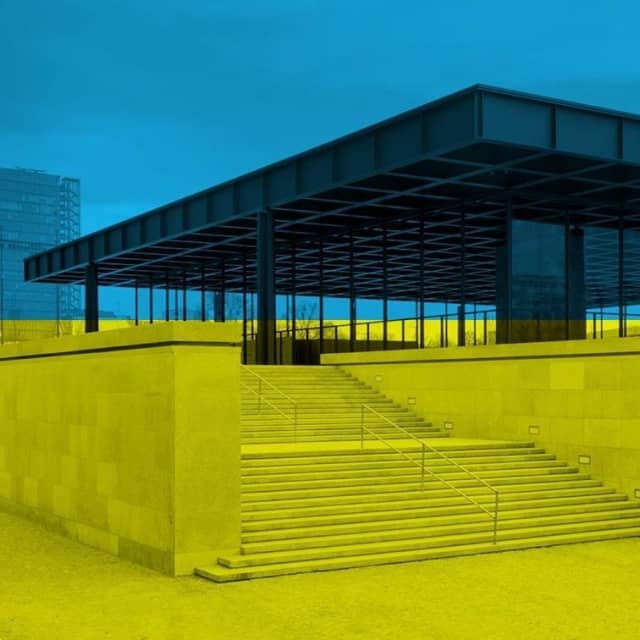
'Our Space to Help', a weekend-long fundraising event in support of Ukraine at Neue Nationalgalerie in Berlin, Saturday, 5 March at 10:00 through Sunday, 6 March at midnight.
Image: Neue Nationalgalerie 2022 © Nationalgalerie – Staatliche Museen zu Berlin / Simon Menges
Together with Berlin's cultural institutions, we are calling for a fundraiser to help people who have fled Ukraine and are arriving in Berlin. We invite you to come to the Neue Nationalgalerie to donate and be together from Saturday, 5 March at 10:00 through Sunday, 6 March at midnight at Neue Nationalgalerie in Berlin.
The fundraising campaign is organised in cooperation with Be an Angel e.V.
Please be welcome to donate on site:
• power banks / batteries for smartphones
• mobile WIFI hotspots
• monetary donations
The staff from Be an Angel e.V. will also provide information about further aid measures on site.
An ‘open microphone’ on site invites you to share your own thoughts, music, poetry, and literature. Your spontaneous contributions will be welcome.
Initiated by Klaus Biesenbach and developed in close collaboration with Anne Imhof and Olafur Eliasson, together with a large group of colleagues and volunteers from the Neue Nationalgalerie and Stiftung Preußischer Kulturbesitz, this is as an open invitation to all Berlin art institutions, artists, and residents.
Be an Angel e.V.
https://beanangel.direct
Donation code: #kunst4ukraine
Account 014 522 59 00 Sort code 100 708 48 (Deutsche Bank)
IBAN DE37100708480145225900 BIC DEUTDEDB110
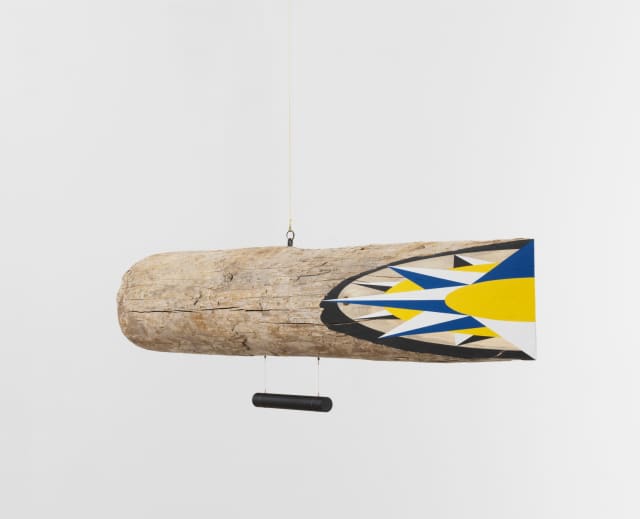
We’ve updated our resource page 'Support humanitarian aid in Ukraine’ with even more links. It now includes organisations and platforms supporting, hosting, and arranging housing for refugees who are already arriving in Berlin from Ukraine. Find it all here:
Support humanitarian aid in Ukraine
Some of these organisations are driving donations and supplies to the border of Ukraine themselves. Also, some of these local resources are available in Ukrainian and Russian languages in addition to English and German.

‘Colour experiment no. 108’, 2020. Photo: Jens Ziehe

Detail of ‘Colour experiment no. 108’, 2020. Now on view at Tanya Bonakdar Gallery, Los Angeles, as part of the solo exhibition ‘Your light spectrum and presence’. Photo: Jens Ziehe
In 2009, Olafur Eliasson began a series of circular paintings inspired by the idea of producing a new, comprehensive colour theory that would comprise all the visible colours of the prism. He began by working with a colour chemist to mix in paint an exact tone for each nanometre of light in the spectrum, which ranges in frequency from approximately 390 to 700 nanometres. Since those initial experiments, Eliasson has branched out to make a large number of painted works on circular canvases, known collectively as the colour experiments. A number of these works take their palettes from other sources, from historical paintings by J. M. W. Turner or Caspar David Friedrich, for example. In the case of ‘Colour experiment no. 108’, the muted tones in the background were derived from the colours found in a photograph taken by the artist in Iceland in 2012. A formless multicolored explosion spreads out from the centre of the canvas, contrasting starkly with the smooth, even background.
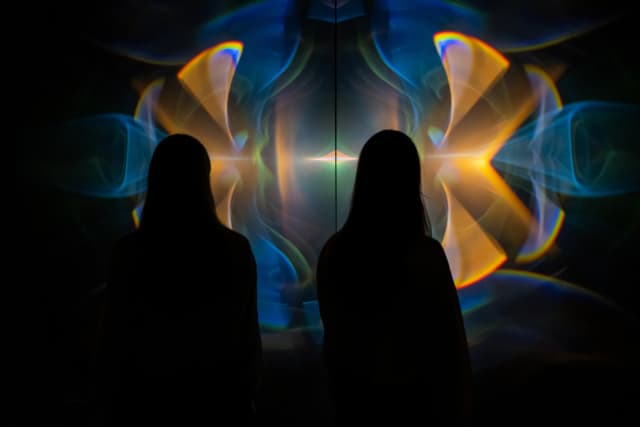
'The missing left brain', 2022. Now on view as part of Olafur Eliasson's solo exhibition 'Navegación situada' at Galería Elvira González, Madrid. Photo: CENIZA
'The missing left brain', 2022, unfurls before the viewer as a constantly changing lightshow of shapes, colours, and shadows, created through the reflection and refraction of light. The symmetrical sequence develops and vanishes in a slow continuum upon a circular screen that seems to hover in the space. The screen is in fact a semicircular screen affixed to a mirror, which creates the illusion of a full circle and doubles the amorphous shapes into a symmetrical Rorschach-like light display.
Viewers can glimpse the apparatus responsible for producing the projection inside a custom-made box mounted behind the screen. The box contains disparate glass lenses, colour-effect filters, and objects from Eliasson’s studio. A light inside the box illuminates the objects as they turn, and the resulting distortions are projected via a lens onto the screen. As each motor revolves at its own pace, the relationship between the various elements constantly changes, so that the light sequence appears always new. Chance alignments produce an ever-changing symphony of shadows and reflections on the screen – a phantasmagoria of evolving shapes, arboreal shadows, spectral arcs, and fields of colour that wax and wane and ooze across the surface of the screen.